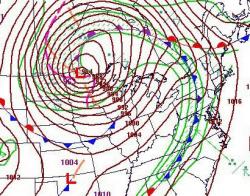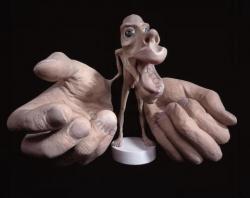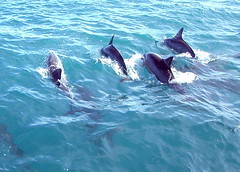October 2010 Archives

Meteorologists know this will be intense due to expected lowest central pressure of the low in western Ontario bottoming out in the neighborhood of 960-970 mb. This is a storm potentially as strong or stronger than the infamous "Edmund Fitzgerald" storm in Nov. 1975 and an even stronger version almost exactly 23 years after that in Nov. 1998.(See the full forecast here.) Rather than "land hurricane," the correct term for the phenomenon we're seeing is (unlikely as it sounds) "bomb cyclogenesis." As related by boingboing:
Basically, bomb cyclogenesis is the formation of an over-land cyclone ("cyclogenesis") in a dramatically short period of time ("kablooey"). The phenomenon might be involved in the formation of Atlantic Nor'easters, and was the force behind some of the biggest blizzards of the mid-20th century. In fact, Minnesota Public Radio's Updraft blog is going so far as to call this incoming weather system a "land hurricane" ("telegram"). The Eastern side of Lake Superior is expecting 25-foot waves this afternoon. Should be exciting. And we've all learned a new word.Bottom line: stay inside tonight.


Cyanide & Happiness @ Explosm.net

You really can't top that.The Berners Street Hoax was perpetrated by Theodore Hook in the City of Westminster, London, in 1810.
On 27 November, at five o'clock in the morning, a sweep arrived to sweep the chimneys of 54 Berners Street, the home of Mrs Tottenham. The maid who answered the door informed him that no sweep had been requested, and that his services were not required, and the disappointed tradesman went on his way. A few moments later another sweep presented himself at the door, then another, and another, 12 in all. After the last of the sweeps had been sent away, a fleet of carts carrying large deliveries of coal began to arrive, followed by a series of cakemakers delivering large wedding cakes, then doctors, lawyers, vicars and priests summoned to minister to someone in the house they had been told was dying. Fishmongers, shoemakers, and over a dozen pianos were among the next to appear, along with "six stout men bearing an organ". Dignitaries, including the Governor of the Bank of England, the Duke of York, the Archbishop of Canterbury and the Lord Mayor of the City of London also arrived. The narrow streets soon became severely congested with disgruntled tradesmen and onlookers. Deliveries and visits continued until the early evening, bringing a large part of London to a standstill.[1]
Hook had bet his friend Samuel Beazley that he could transform any house in London into the most talked-about address in a week. To achieve his goal he had sent out 4,000 letters purporting to be Mrs Tottenham, requesting deliveries, visitors, and assistance. Hook had stationed himself in the house directly opposite 54 Berners Street, and he and his friend had spent an amusing day watching the chaos unfold.[1]

Black hole physics, in which space and time become compressed, provides a basis for math showing that the third dimension may not exist at all. In this two-dimensional cartoon of a universe, what we perceive as a third dimension would actually be a projection of time intertwined with depth. If this is true, the illusion can only be maintained until equipment becomes sensitive enough to find its limits.
"You can't perceive it because nothing ever travels faster than light," says Hogan. "This holographic view is how the universe would look if you sat on a photon."
Not everyone agrees with this idea. Its foundation is formed with math rather than hard data, as is common in theoretical physics. And although a holographic universe would answer many questions about black hole physics and other paradoxes, it clashes with classical geometry, which demands a universe of smooth, continuous paths in space and time.
"So we want to build a machine which will be the most sensitive measurement ever made of spacetime itself," says Hogan. "That's the holometer."
Read the whole article here, and be confused.


 an a random patch of skin on the back. Note how the motor homunculus is almost entirely hand and mouth - makes sense. (From the London Natural History Museum.)
an a random patch of skin on the back. Note how the motor homunculus is almost entirely hand and mouth - makes sense. (From the London Natural History Museum.) 

Image by jurvetson via Flickr
When two dolphin species come together, they attempt to find a common language, preliminary research suggests.
Bottlenose and Guyana dolphins, two distantly related species, often come together to socialise in waters off the coast of Costa Rica.
Both species make unique sounds, but when they gather, they change the way they communicate, and begin using an intermediate language.
That raises the possibility the two species are communicating in some way.
See the rest of this article here!

 seems to fit that description, although perhaps "1920s urban Americana" might also apply. It seems that during the Texas oil boom of the Roaring Twenties, a traveling con man fooled investors into constructing a 4-story "skyscraper":
seems to fit that description, although perhaps "1920s urban Americana" might also apply. It seems that during the Texas oil boom of the Roaring Twenties, a traveling con man fooled investors into constructing a 4-story "skyscraper":No one noticed that all the plans, promotional literature, etc. had tiny decimal points in all the crucial figures. i.e. 4.0 stories was taken as 40 stories. The project was oversubscribed by quite a bit and the project built to completion, upon which the promoter skipped town.The investors started trying to sue or arrest him when the swindle became evident during construction, but were unable to since the contract was followed to the letter. They did recover a few dollars from the elevator company (who refused to honor their contract after they discovered the decimal points). Unable to get the crook, the investors funded a team which followed him around the country breaking up any deals he tried to put together.
You can read more here.

Check out this official video footage. Not quite as spine-chilling as Terminators, but getting there:
In the meantime, on the other side of the country, researchers at Carnegie Mellon are attempting to duplicate human learning processes in machines:
Since the start of the year, a team of researchers at Carnegie Mellon University -- supported by grants from the Defense Advanced Research Projects Agency and Google, and tapping into a research supercomputing cluster provided by Yahoo -- has been fine-tuning a computer system that is trying to master semantics by learning more like a human. Its beating hardware heart is a sleek, silver-gray computer -- calculating 24 hours a day, seven days a week -- that resides in a basement computer center at the university, in Pittsburgh. The computer was primed by the researchers with some basic knowledge in various categories and set loose on the Web with a mission to teach itself.(Read more here.) Bring these two together, and what do you get? Well... we'll find out. (Along these lines - check out this NPR segment, "Can Unmanned Robots Follow the Laws of War?")

Full article.It looks like any other sea slug, aside from its bright green hue. But the Elysia chlorotica is far from ordinary: it is both a plant and an animal, according to biologists who have been studying the species for two decades.Not only does E. chlorotica turn sunlight into energy -- something only plants can do -- it also appears to have swiped this ability from the algae it consumes.Native to the salt marshes of New England and Canada, these sea slugs use contraband chlorophyll-producing genes and cell parts called chloroplasts from algae to carry out photosynthesis, says Sidney Pierce, a biologist at the University of South Florida in Tampa.That genetic material has since been passed down to the next generation, eliminating the need to consume algae for energy.



